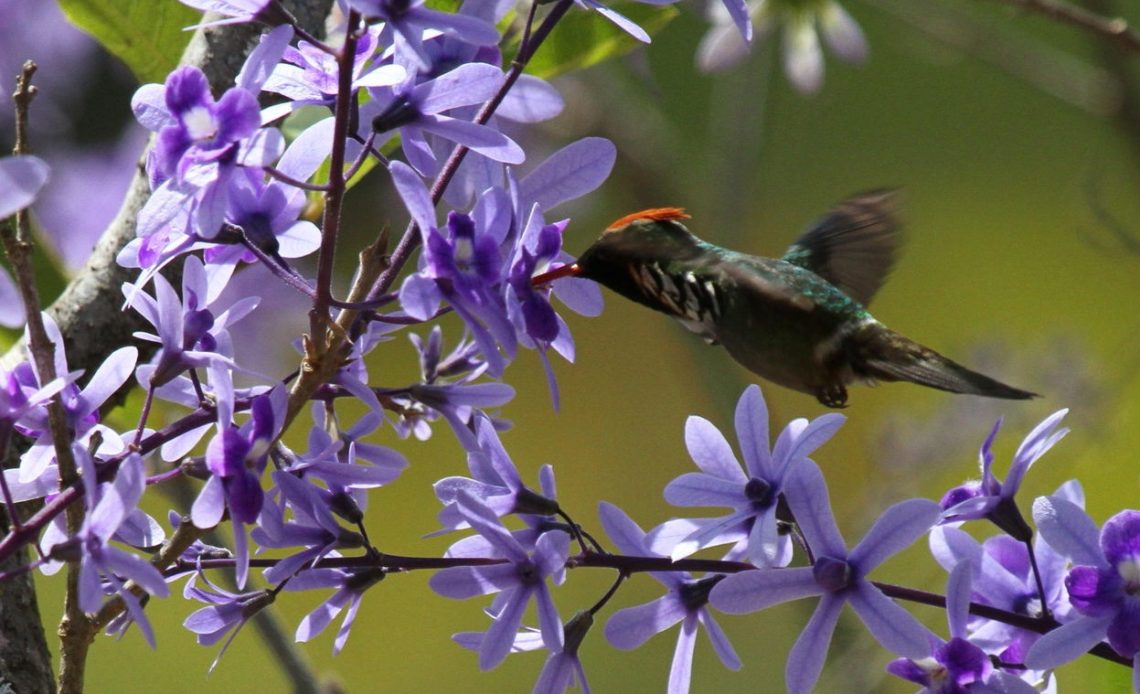

We’re here to help! Wild Yards is a completely free website that is 100% dedicated to helping you create a wildlife-friendly, sustainable yard. Read more
WildYards is reader-supported. When you buy a product through a link on our site, we may earn a comission. Every product is independently selected by our (obsessive) editors and our reviews are unbiased and objective. Read more about our mission or our privacy policy.
Wisteria is an interesting vine, with plentiful flowers and interesting clusters. They are fantastic to watch growing – and although wisteria is not necessarily well-known for attracting certain pollinators such as bees and butterflies, there may be one pollinator who absolutely loves it. Do hummingbirds like wisteria?
Hummingbirds love wisteria. Many gardeners have found that simply growing this vine in their garden is a great way to attract nectar-hunting birds. It’s mainly thanks to its unique blossom, which is almost exclusively accessible to hummingbirds.
Why do hummingbirds like wisteria so much?
Wisteria is perfectly shaped for hummingbird pollination, and not so much for insects. Each blossom falls downwards into a tubular shape. This is ideal for hummingbirds to flutter underneath and probe into with their pump-like tongues. The clusters are close together, too, limiting the traveling and searching they normally have to take.
Wisteria’s curious blossom shape means that while bees and butterflies may show a little interest here and there, they normally won’t get nectar from them. Therefore, hummingbirds have a virtually free meal without the threat of insects getting there first!
Typically, bees and butterflies will need to stand or perch to feed on flowers. As wisteria requires pollinators to hover mid-air, it’s only the hummingbird that stands a chance of getting a taste.
Wisteria typically bursts in blooming shades of purple, pink, and white. Their clusters make them easy to spot from afar, thus ideal for the roving hummingbird in the hunt for a quick feast. Hummingbirds need ample calories to survive – and with a wisteria vine replete with bountiful flowers, they normally won’t need to look anywhere else.
Wisteria vines will also branch out and cluster wildly, meaning if you give it plenty of room to propagate and grow, you will likely have an instant hummingbird attractor (and feeder) for much time to come.
Tips for growing wisteria
Before you start growing wisteria to attract hummingbirds, make sure you check that you’re in USDA zones 3 to 9. It’s here where they will be the hardiest in growth, and you’ll normally find them blossoming in the springtime.
If you’ve ever heard of wisteria referred to as a bush, it’s a myth – this is technically a fast-spreading vine that looks bush-like to the untrained eye! Therefore, as a vine, it’s important you find somewhere that your new plant can easily scale up and balance.
Wisteria grows best with a support behind it, such as a wall. The taller the wall, the better, so if your garden fences are relatively low, opt for an outer wall of your house or outbuilding where possible.
Wisteria needs nutritious, well-drained soil. To keep it thriving, ensure that the soil remains moist. It is usually best to prune it before the spring, ideally in February, and towards the end of the summer, ideally in August.
When planting, do so in a cooler season, such as spring or fall. Every month, give it some high potash fertilizer, which will help promote more blooms. It will need plenty of manure and/or compost to stay well-fed and withstand the cold in the winter.
While great for attracting hummingbirds, wisteria can take quite some time to flower. If your vine is younger than four years old, then it is completely normal for it not to have many blooms, if any at all. Leave it be, and remember to keep it well-fed with fertilizer, compost, and manure. The soil should also remain moist, but not wet, so as not to rot the roots.
After a while, you will start to notice blooms. Thankfully, as long as you do take care of it, your wisteria will continue to bloom every year, only increasing in beauty – and bringing hummingbird visitors, too.
Of course, if you want to speed up the process of welcoming hummingbirds to your garden, there are other vines they show interest in.
What other vines attract hummingbirds?
Some of the best vines to attract hummingbirds include honeysuckle, mandevilla, passion flowers, trumpet vines, hyacinth bean vines, and clematis.
For all of these vines, it is essential to provide the right support and nutritious soil. They do well in full sunlight and need plenty of water throughout the warmer seasons.
However, as time-consuming as caring for them may appear to be, they will provide you with an abundance of beautiful and rare flowers and bring plenty of pollinators to your garden.
Wisteria is a wonderfully rewarding plant, which, when given time and care, will almost always bring local hummingbirds flocking. There are, of course, other hummingbird-friendly flowers that will take up much less of your time!
